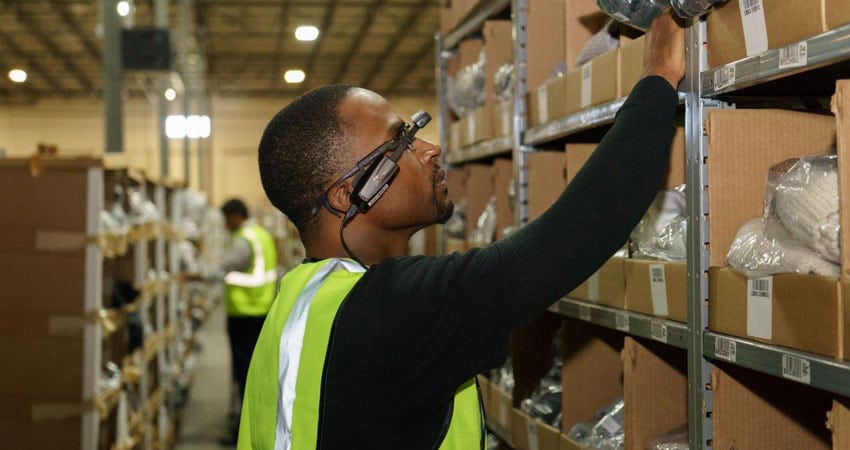Using augmented reality (AR) glasses that includes a heads-up display (HUD) field for warehouse associates is helping improve picking accuracy and productivity, with other applications in view as well, attendees were told at Ecommerce Operations Summit in Columbus, OH.
Adrian Kumar, Vice President of Solutions Design, North America for DHL Supply Chain, said his company has been testing the use of AR glasses in picking operations at eight facilities worldwide since 2015. Given the right kind of profile – low density, high SKU count, cluster picking for e-fulfillment – DHL has seen average productivity gains of 10% to 15%.
“That’s not necessarily a game- changing productivity increase, but for something has a similar cost basis to a standard pick assist device, that you can switch out to your existing operations, I think it’s pretty significant,” Kumar said during his session.
Kumar said for DHL the cost of an AR solution is “more than an RF gun, but nowhere near the equipment for pick to light.” He added that AR provides much more operational flexibility than either RF or pick-to-light systems.
Krishna Venkatasamy, Chief Technology Officer of Lucas Systems, who co-presented with Kumar, said AR devices provide not only navigation guidance to warehouse associates but tell them what to pick and the quantity. “It’s not just how to use the hardware, but how the software can enable operations to be more efficient,” Venkatasamy said.
He added ease of use is a critical factor for warehouse AR applications like this. “If you don’t design the software to make sure the operator gets what he needs, it’s not helping with his job and you’re not seeing productivity gains,” Venkatasamy said. “The experience has to be easy to use, so they benefit from the technology. The software has to adapt to different operations, different users’ abilities. And the hardware needs to have the right battery life and ergonomics.”
Kumar said DHL decided to test out AR in ecommerce picking first due to the higher cost base vs. retail fulfillment or replenishment.
“In ecommerce operations you have three times the labor and five to six times the cost of a typical retail operation,” he said. “And we know there’s a labor shortage, with 30% more workers needed than are available today to work in a DC. Finding a way to be more efficient and productive in the DC is very important to us as a company, which is why we launched these AR pilots.”
Kumar said AR solutions provide the options of adding item images in the HUD screen, and integrating voice commands to confirm a pick and request the next pick location or assignment. Option: image. Quantity to pick, and allocation of quantity onto pick cart.
“The scanners on the glasses pick up item numbers, slot locations, barcodes and locations on a cart,” he said. “They also use a finger scanner, and you might ask why if the AR glasses have a scanner. That’s because in a DC, pickers have to bend down to the first level, and it might be awkward to navigate with just a camera on the glasses.”
DHL has been testing AR in other use cases, including kitting and packing, Kumar said. With packers busy keeping up with production schedules, especially at peak periods, they may use more box than is necessary, adding to shipping costs that are dimensionally calculated.
“In e-fulfillment, you can have multiple general merchandise items going into a box, so it comes down to how the packer orients them in a box. If they’re frustrated making it fit, they grab a bigger box. We see vision helping give them instructions to guide them through the process.”
Augmented reality can ultimately be used for guiding non-technical associates step-by-step through remote maintenance tasks to fix basic issues with robots or conveyance systems, Kumar said, saving on support costs. He said they could also be used for associate training at peak, immersing new hires in realistic scenarios involving common DC features like mezzanines and put walls.

